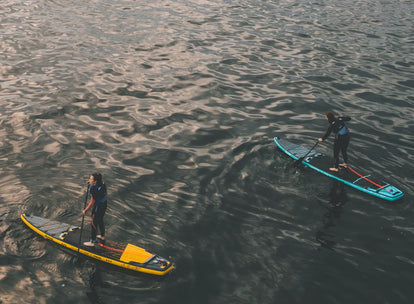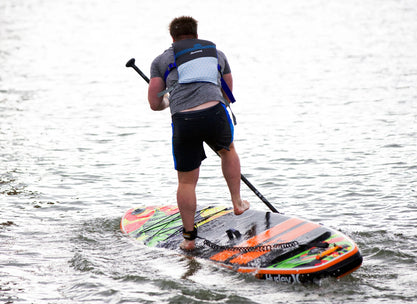Paddleboarding is wonderfully accessible, with people of all ages and abilities able to find enjoyment being out on the water. It really doesn’t matter how fast you can paddle - you’ve put yourself out there to pick up a new hobby at the end of the day, and you should be proud of that.
However, it’s only natural to want to be as proficient out on the water as your abilities allow you to be. So, with that, we’ve put together a list of top tips which will help beginners to find their feet on a stand up paddle board (SUP) in just 30 minutes.
1. Start on your knees
Despite being called stand up paddling, starting on your knees is the best way to launch, both to avoid a tumble near the bank and also to allow you to practice the paddle strokes before you progress to standing up.
Once you are safely out on clear water, away from obstructions, you can try standing, with plenty of soft water to land in if it doesn't go to plan! Return to a kneeling position when you come back in to land.
2. Look to the horizon
Keep your gaze forwards. It’s natural to look down at the board or at your feet as you move from knelt to crouched to upright, but that will only exacerbate any wobbles.
Look at the horizon and use your natural sense of balance to steady yourself. Once moving along it‘s equally important to keep an eye on your environment, other water users and where you are headed. Keeping your eye line up will also help with balance, too.
3. Put faith in your paddle
As you stand up, get the paddle blade into the water. Even a little contact with the water will help you balance better and give you an instinctive sense of the movement of the board, allowing you to better compensate for any movement.
Also, as you get more confident and start to move your positioning on the board, having the paddle in the water while you do so will be key to staying upright.
4. Avoid leg lock
Keeping your knees a little bent ‘springy’ is essential once you are upright. In this position, you are ready to absorb any waves and wobbles through the ‘suspension rods’ that are your legs.
Letting your legs ‘lock’ into a straight position will make it very hard to absorb any lumps or bumps without toppling forward or backward at the waist. The key to effortless balance is to learn to relax in this ‘ready’ position so you can quickly lower your centre of gravity and ride out the ripples.
5. Keep those feet central
Most boards have a useful carry handle right in the centre of the board. This handily denotes
the centre of the board, both longways and widthways. It’s the best spot to stand in normal paddling as it is generally the widest part and also the midpoint along the length, so the board will trim to sit flat on the water.
If you look down and don’t see the handle between your knees/feet, then shuffle back to the right position for regular paddling.
6. Vertical strokes are key to straight paddling
The key to keeping a straight heading is very vertical paddle strokes. With the paddle upright and close to the board you won’t produce so much turning power as you paddle, helping to keep the board straight.
Press down on the top of the paddle, driving it into the water at the front of the stroke, using your body weight to propel the SUP forwards, and bring the paddle out before your feet. Dragging the paddle behind you pushes water upwards and slows the board down. It can also unbalance you and takes longer to get the paddle back to the front of the stroke - so lots of short downward strokes, using your core, are the answer!
Swap sides regularly to keep the board on course. As you improve you will notice you need to swap sides less often.
7. Stretch it out to turn
To get your board turning effectively, it’s almost the opposite approach to straight line paddling: bring the paddle low and almost horizontal to the board, reaching out as far as you can from the board and drawing the paddle blade around in the water from the nose to the tail in a big rainbow shape.
This move will rapidly turn the board, even more so if you combine it with the same stroke in reverse on the opposite side. A reverse stroke, will of course slow the board down - useful if you are heading towards something you don’t want to hit! Combine two reverse strokes on different sides and you can very quickly bring your board to a stop.
8. Wear your buoyancy aid with pride
There’s always a good case for wearing a buoyancy aid when out paddling - if you fall in and become separated from the board then it could save your life. It’s important though to ensure you fit it correctly: do up the lower and middle straps first to ensure your buoyancy aid won’t ride up above your head when you are in the water.
Test your fit by pulling up under the shoulder straps to make sure they don’t ride up above your ears. If they do, tighten up those waist and chest straps!
9. Don’t ignore your leash
Your safety leash is essential for connecting you to your board i.e., your main source of floatation and transport. Most boards will come with an ankle leash which is great for flat and sheltered water paddling, but if you venture out on fast-flowing or obstructed waters then consider using a waist leash with a quick-release mechanism.
This extra bit of safety means you can separate from the board and leash if you become entangled and swim to safety, before trying to recover your board. Combined with your buoyancy aid, this keeps you prepared for all eventualities, plus you’ll be much safer on moving water.
10. Pack some essentials
Taking a few essentials with you on will make each SUP trip much more enjoyable, not to mention safer. Get a good waterproof dry-bag and make sure any important items inside are also double bagged or waterproofed to be on the safe side!
What you take with you will vary depending on the conditions, weather and length and location of your paddle, but consider these:
- First aid kit
- Spare clothes / extra layers
- Food and drink
- Spare paddle, pump and fin
- Phone (for communication and photos)
- Tape, repair kit, multi-tool and other items to help fix or repair anything in the field
And finally, whenever and wherever you paddle, remember that paddleboarding is safer and more fun as a group activity, so get some friends involved! Always let someone know where you are headed and when to expect you back. Prepare well for each trip and a whole world of enjoyable SUP adventures await.


